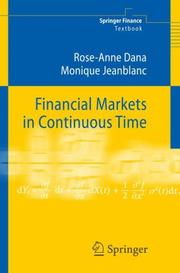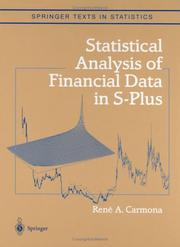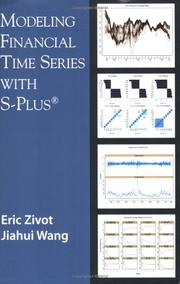| Listing 1 - 5 of 5 |
Sort by
|

ISBN: 354071149X 3540711503 9783540711490 3540434038 Year: 2007 Publisher: Berlin: Springer,
Abstract | Keywords | Export | Availability | Bookmark
 Loading...
Loading...Choose an application
- Reference Manager
- EndNote
- RefWorks (Direct export to RefWorks)
In modern financial practice, asset prices are modelled by means of stochastic processes, and continuous-time stochastic calculus thus plays a central role in financial modelling. This approach has its roots in the foundational work of the Nobel laureates Black, Scholes and Merton. Asset prices are further assumed to be rationalizable, that is, determined by equality of demand and supply on some market. This approach has its roots in the foundational work on General Equilibrium of the Nobel laureates Arrow and Debreu and in the work of McKenzie. This book has four parts. The first brings together a number of results from discrete-time models. The second develops stochastic continuous-time models for the valuation of financial assets (the Black-Scholes formula and its extensions), for optimal portfolio and consumption choice, and for obtaining the yield curve and pricing interest rate products. The third part recalls some concepts and results of general equilibrium theory, and applies this in financial markets. The last part is more advanced and tackles market incompleteness and the valuation of exotic options in a complete market.
Options (Finance) --- Equilibrium (Economics) --- Mathematical models. --- -332.0151955 --- Mathematical models --- Options (Finances) --- Equilibre (Economie politique) --- Modèles mathématiques --- EPUB-LIV-FT LIVMATHE SPRINGER-B --- 332.0151955 --- 305.91 --- AA / International- internationaal --- Econometrie van de financiële activa. Portfolio allocation en management. CAPM. Bubbles --- Economics, Mathematical . --- Probabilities. --- Quantitative Finance. --- Probability Theory and Stochastic Processes. --- Probability --- Statistical inference --- Combinations --- Mathematics --- Chance --- Least squares --- Mathematical statistics --- Risk --- Economics --- Mathematical economics --- Econometrics --- Methodology --- Options (Finance) - Mathematical models --- Equilibrium (Economics) - Mathematical models
Book
ISBN: 9780470583623 Year: 2010 Publisher: Hoboken, N.J. Wiley
Abstract | Keywords | Export | Availability | Bookmark
 Loading...
Loading...Choose an application
- Reference Manager
- EndNote
- RefWorks (Direct export to RefWorks)
"This book is designed to help readers grasp the conceptual underpinnings of time series modeling in order to gain a deeper understanding of the ever-changing dynamics of the financial world. It covers theory and application equally for readers from both financial and mathematical backgrounds"-- "This book is designed to help readers grasp the conceptual underpinnings of time series modeling in order to gain a deeper understanding of the ever-changing dynamics of the financial world. It covers theory and application equally for readers from both financial and mathematical backgrounds. The book offers succinct coverage of standard topics in statistical time series - such as forecasting and spectral analysis - in a manner that is both technical and conceptual. Recent developments in nonstandard time series techniques such as Bayesian methods and arbitrage statistics have been added to this edition, and they are illustrated in detail with real financial examples. Subroutines in R and S-Plus are lavishly displayed throughout in this new edition. An author website provides instructor notations and additional software subroutines, as well as complete solutions to the exercises in the text."--
Econometrics --- Risk management --- Time-series analysis --- 332.0151955 --- 303.0 --- 304.0 --- 305.970 --- AA / International- internationaal --- Analysis of time series --- Statistische technieken in econometrie. Wiskundige statistiek (algemene werken en handboeken) --- Zuivere statistische analyse (algemene naslagwerken). Tijdreeksen --- Algemeenheden: Autoregression and moving average representation. ARIMA. ARMAX. Lagrange multiplier. Wald. Function (mis) specification. Autocorrelation. Homoscedasticity. Heteroscedasticity. ARCH. GARCH. Integration and co-integration. Unit roots --- Mathematical statistics --- Autocorrelation (Statistics) --- Harmonic analysis --- Probabilities --- Insurance --- Management --- Economics, Mathematical --- Statistics

ISBN: 0387202862 9786610189076 128018907X 0387218246 Year: 2004 Publisher: New York, NY : Springer New York : Imprint: Springer,
Abstract | Keywords | Export | Availability | Bookmark
 Loading...
Loading...Choose an application
- Reference Manager
- EndNote
- RefWorks (Direct export to RefWorks)
Although there are many books on mathematical finance, few deal with the statistical aspects of modern data analysis as applied to financial problems. This book fills this gap by addressing some of the most challenging issues facing any financial engineer. It shows how sophisticated mathematics and modern statistical techniques can be used in concrete financial problems. Concerns of risk management are addressed by the control of extreme values, the fitting of distributions with heavy tails, the computation of values at risk (VaR), and other measures of risk. Data description techniques such as principal component analysis (PCA), smoothing, and regression are applied to the construction of yield and forward curve. Nonparametric estimation and nonlinear filtering are used for option pricing and earnings prediction. The book is intended for undergraduate students majoring in financial engineering, or graduate students in a Master in finance or MBA program. Because it was designed as a teaching vehicle, it is sprinkled with practical examples using market data, and each chapter ends with exercises. Practical examples are solved in the computing environment of S-PLUS. They illustrate problems occurring in the commodity and energy markets, the fixed income markets as well as the equity markets, and even some new emerging markets like the weather markets. The book can help quantitative analysts by guiding them through the details of statistical model estimation and implementation. It will also be of interest to researchers wishing to manipulate financial data, implement abstract concepts, and test mathematical theories, especially by addressing practical issues that are often neglected in the presentation of the theory. Rene Carmona is the Paul M. Wythes '55 Professor of Engineering and Finance at Princeton University in the department of Operations Research and Financial Engineering and Director of Graduate Studies of the Bendheim Center for Finance. His publications include over seventy articles and six books in probability and statistics. He was elected Fellow of the Institute of Mathematical Statistics in 1984, and he is on the editorial board of several peer-reviewed journals and book series. Professor Carmona has developed computer programs for teaching of statistics, for research in signal analysis, and more recently, he contributed the library EVANESCE for the analysis of heavy tail distributions and copulas. The latter was included in the latest version of S-Plus. He has worked for many years on energy and weather derivatives, and he is recognized as a leading researcher and consultant in this area.
Private finance --- Mathematical statistics --- Finance --- Finance - General --- Business & Economics --- Mathematical models --- Econometric models --- -Finance --- -332.0151955 --- Funding --- Funds --- Economics --- Currency question --- S-Plus. --- SPlus --- Business. --- Business mathematics. --- Economics, Mathematical. --- Actuarial science. --- Computer mathematics. --- Statistics. --- Business and Management. --- Business Mathematics. --- Actuarial Sciences. --- Computational Mathematics and Numerical Analysis. --- Statistics for Business/Economics/Mathematical Finance/Insurance. --- Quantitative Finance. --- Computer science --- Finance. --- Statistics for Business, Management, Economics, Finance, Insurance. --- Mathematics. --- Mathematical statistics. --- Statistics . --- Economics, Mathematical . --- Mathematical economics --- Econometrics --- Mathematics --- Statistical analysis --- Statistical data --- Statistical methods --- Statistical science --- Computer mathematics --- Electronic data processing --- Statistics --- Insurance --- Arithmetic, Commercial --- Business --- Business arithmetic --- Business math --- Commercial arithmetic --- Methodology
Book
ISBN: 9780470414354 9786612707834 0470414359 9780470644553 1282707833 0470644567 0470644559 9781282707832 9780470644560 Year: 2010 Publisher: Cambridge, Mass. : Wiley,
Abstract | Keywords | Export | Availability | Bookmark
 Loading...
Loading...Choose an application
- Reference Manager
- EndNote
- RefWorks (Direct export to RefWorks)
This book provides a broad, mature, and systematic introduction to current financial econometric models and their applications to modeling and prediction of financial time series data. It utilizes real-world examples and real financial data throughout the book to apply the models and methods described. The author begins with basic characteristics of financial time series data before covering three main topics: Analysis and application of univariate financial time seriesThe return series of multiple assetsBayesian inference in finance methods Key f
Mathematical statistics --- Time-series analysis --- Econometrics --- Risk management --- Time-series analysis. --- Econometrics. --- Risk management. --- AA / International- internationaal --- 305.91 --- 304.0 --- 305.970 --- 519.2 --- Econometrie van de financiële activa. Portfolio allocation en management. CAPM. Bubbles. --- Zuivere statistische analyse (algemene naslagwerken). Tijdreeksen. --- Algemeenheden: Autoregression and moving average representation. ARIMA. ARMAX. Lagrange multiplier. Wald. Function (mis) specification. Autocorrelation. Homoscedasticity. Heteroscedasticity. ARCH. GARCH. Integration and co-integration. Unit roots. --- Probability. Mathematical statistics --- 519.2 Probability. Mathematical statistics --- -Econometrics --- -Risk management --- -332.0151955 --- Insurance --- Management --- Economics, Mathematical --- Statistics --- Analysis of time series --- Autocorrelation (Statistics) --- Harmonic analysis --- Probabilities --- Electronic information resources --- E-books --- Statistics - General --- Social Sciences --- Zuivere statistische analyse (algemene naslagwerken). Tijdreeksen --- Econometrie van de financiële activa. Portfolio allocation en management. CAPM. Bubbles --- Algemeenheden: Autoregression and moving average representation. ARIMA. ARMAX. Lagrange multiplier. Wald. Function (mis) specification. Autocorrelation. Homoscedasticity. Heteroscedasticity. ARCH. GARCH. Integration and co-integration. Unit roots --- Analyse des données --- Analyse des données

ISBN: 0387955496 0387916245 0387217630 9780387955490 Year: 2003 Publisher: New-York: Spinger,
Abstract | Keywords | Export | Availability | Bookmark
 Loading...
Loading...Choose an application
- Reference Manager
- EndNote
- RefWorks (Direct export to RefWorks)
Mathematical statistics --- 519.2 --- 330.115 --- Finance --- -Time-series analysis --- -AA / International- internationaal --- 305.91 --- 305.7 --- 304.0 --- 303.0 --- -332.0151955 --- Funding --- Funds --- Economics --- Currency question --- Analysis of time series --- Autocorrelation (Statistics) --- Harmonic analysis --- Probabilities --- Probability. Mathematical statistics --- Econometrie --- Mathematical models --- Econometric models --- Econometrie van de financiële activa. Portfolio allocation en management. CAPM. Bubbles. --- Econometrie van het gedrag van de financiële tussenpersonen. Monetaire econometrische modellen. Monetaire agregaten. vraag voor geld. Krediet. Rente. --- Zuivere statistische analyse (algemene naslagwerken). Tijdreeksen. --- Statistische technieken in econometrie. Wiskundige statistiek (algemene werken en handboeken). --- S-Plus. --- SPlus --- 330.115 Econometrie --- 519.2 Probability. Mathematical statistics --- Econometrics. --- Computer software. --- Programming languages (Electronic computers). --- Statistics . --- Economics, Mathematical . --- Mathematical Software. --- Programming Languages, Compilers, Interpreters. --- Statistics for Business, Management, Economics, Finance, Insurance. --- Quantitative Finance. --- Computer languages --- Computer program languages --- Computer programming languages --- Machine language --- Electronic data processing --- Languages, Artificial --- Software, Computer --- Computer systems --- Economics, Mathematical --- Statistics --- Mathematical economics --- Econometrics --- Mathematics --- Statistical analysis --- Statistical data --- Statistical methods --- Statistical science --- Methodology --- Econometrie van de financiële activa. Portfolio allocation en management. CAPM. Bubbles --- Econometrie van het gedrag van de financiële tussenpersonen. Monetaire econometrische modellen. Monetaire agregaten. vraag voor geld. Krediet. Rente --- Zuivere statistische analyse (algemene naslagwerken). Tijdreeksen --- Statistische technieken in econometrie. Wiskundige statistiek (algemene werken en handboeken) --- -Finance --- -Mathematical models
| Listing 1 - 5 of 5 |
Sort by
|

 Search
Search Feedback
Feedback About UniCat
About UniCat  Help
Help News
News